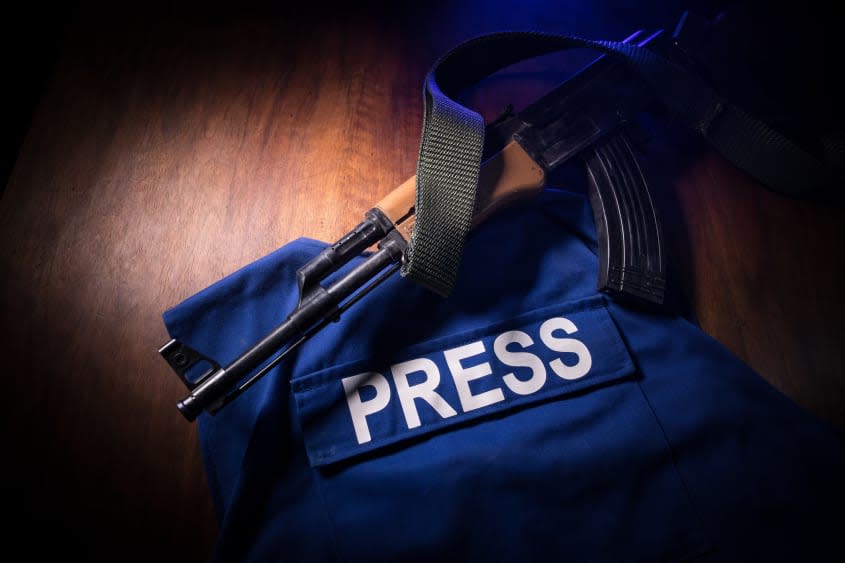Why journalist deaths continue to rise around the world

Mexico is reeling from a pair of shocking journalist deaths. The director of a local news site in Acapulco Nelson Matus was shot to death in his car in what was reportedly the third assassination attempt against him. Matus' death came just one week after the body of Luis Martin Sanchez, a reporter for Mexican national newspaper La Jornada, was discovered near the city of Tepic.
But Mexico is hardly alone in the epidemic of violence against journalists. Across the world, 67 journalists, writers and reporters were killed in 2022, according to the Committee to Protect Journalists (CPJ). This represents the "highest number [of journalist deaths] since 2018 and an almost 50% increase from 2021," CPJ reported. And that violence has only continued in 2023, as CPJ has tracked 14 journalists who have been killed so far this year.
Violence against journalists isn't new, as front-line reporting has always been a risky profession. Even in the United States, "violent acts against the media are as old as our nation," The Conversation reported. But what has led to the continued spate of violent, and often deadly, assaults against journalists in recent years?
Where are journalists mostly being killed?
Many journalist deaths in 2022 were due to the breakout of war in Ukraine, and this has continued in 2023. Producer Bohdan Bitik and AFP video journalist Arman Soldin were killed during Ukrainian-Russian crossfire, with Bitik "shot and killed on April 26" and Soldin "killed in a rocket attack on May 9," according to CPJ. This is a continuation of the staggering 15 reporters killed in Ukraine last year, and "journalists covering the war in Ukraine 'face enormous risk,'" CPJ said, per The Associated Press.
Half of the journalist deaths in 2022 occurred in just three countries, CPJ reported: Ukraine, Mexico and Haiti. However, this year has seen a larger rise in journalist deaths on one specific continent: Africa. Much of this violence is concentrated in the west-central African nation of Cameroon, which is "one of the most oppressive countries on the continent," The Guardian reported. Two reporters, broadcaster Martinez Zogo and radio presenter Jean-Jacques Ola Bebe, were killed this year, CPJ reported. A common motto for reporters in Cameroon has become "you can kill a journalist but you cannot kill the story," per The Guardian. But this is not the only African country where violence is being seen, as CPJ has also reported journalist deaths in Rwanda and Lesotho.
Latin America and the Caribbean have also been a hotbed of journalistic violence, with CPJ reporting 30 deaths in this region in 2022 — more than in Ukraine. Deaths in these countries have continued this year, with CPJ reporting journalists killed in Colombia and Paraguay, along with the two deaths in Mexico.
What has led to this rise in violence?
While the violence in Ukraine is an obvious factor, a rise in "global political instability" is leading to violence against journalists who are not in war zones, CPJ President Jodie Ginsburg told PBS. Ginsburg noted that the high level of deaths in Latin America has come even though the region is "officially not in any conflict."
In Mexico, for example, "we see journalists killed for covering corruption, particularly in local politics," Ginsburg said, noting that "local journalists are incredibly vulnerable. They often don't have the protections afforded to them by working for a big national media outlet." In Haiti, where journalists are often targeted, there has "effectively [been] a complete collapse of any authority," Ginsburg said. "People are covering gang warfare, but it's all part of a bigger pattern of increased lawlessness in the region."
The most dangerous time to be a journalist is "often not when an autocratic government is in full control," journalist Katherine Corcoran told The New York Times, "but when democracy begins to take hold and the power centers shift."
Even the dichotomy of covering conflicts has changed, "as even war reporters were once protected by the symbiotic relationship they had with those they covered," The New Republic reported in 2018. Combatants had to talk to journalists to communicate with the outside world, so "killing journalists, quite simply, undermined their ability to get their message out." However, "that dynamic changed with the advent of the internet," allowing for the continued carnage against journalists to go largely unchecked.
You may also like
Florida construction and agricultural workforces diminished after new immigration law takes effect
Judge limits how Biden officials can communicate with social media companies
How solar and wind energy are saving Texans from a record heatwave

